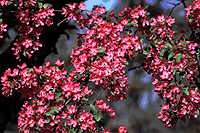Colorful Blooms Overshadowing Tree And Shrub Damage from Last Year's Drought
Colorful Blooms Overshadowing Tree And Shrub Damage from Last Year's Drought

The brilliant displays of early blooming trees and shrubs are covering drought damage that is likely to show up later in many parts of Kentucky. The Kentucky Cooperative Extension Service is urging homeowners to provide extra care for landscape plants that were put on short water rations last fall.
This year's abundant blossoms were due to some timely rain that dropped on a parched Kentucky in mid-August.
"Most flower buds form on the trees and shrubs about six months before they bloom and we received some timely rain last August," said Bill Fountain, Extension ornamental horticulture specialist in the UK College of Agriculture.
"The plants took up that water from those rains in August and with the help of some long sunny days, they were really cranking out the carbohydrates," added Fountain. "The plants sensed that they were in good shape at that time of year, so they produced lots of flowers."
But the drought already has killed some plants and taken a hidden toll on others. Some of the first victims of drought stress were the conifers that began to wilt last fall. Sadly, many of those evergreen trees and shrubs will not recover.
"Canadian Hemlock will just drop its needles and dies without much warning." said Fountain. "Pines that are completely brown are dead. Spruce will lose some of their color under stress and they are starting to lose their needles right now. They will never look as good as they did before the drought."
"Most deciduous trees will fare better than conifers because many of them drop foliage and cope with the drought by going into an early dormancy, " noted John Hartman, Extension plant pathologist in the UK College of Agriculture. "Conifers can lose moisture through their needles all winter long. If the drought continues, that transpiration continues and needles begin to turn brown and drop and eventually the tree dies."
Deciduous trees and shrubs that may need special attention this year are likely the youngest and oldest plants.
"Very young plants are susceptible because of a limited root system due to transplanting," said Fountain. "Very old trees are stressed because they were already slowing down and they had more plant to support, which in turn required more water and many were already under a lot of stress."
Older trees may begin to die earlier than expected because a large amount of their conductive tissue was damaged.
"The decline process may take five to ten years because larger trees do have a lot of stored nutrients," said Fountain. "But their life expectancy has been shortened because of drought damage."
There are some fundamental survival tips for trees and shrubs. Hartman and Fountain both note that the amount and kind of damage control will depend on the site, the care that site received during the drought, and the species of tree or shrub planted in that area.
Spring rains have regenerated community water supplies and homeowners should be watering on a regular basis.
"Watering should be deep and thorough and done once per week," suggested Fountain. "This may involve watering twice in one day. Let the first watering soak in for a half-day and then come back and water again."
This is not a good time to fertilize trees or shrubs because a lot of fertilizers actually increase the demand for water.
"If you fertilize now, you tend to induce more succulent growth and longer stems," added Fountain. "So we recommend limited fertilization now and suggest that the best time for fertilizer on these plants is in the fall of the year."
Location also could be a key. The front yard often has more problems than the back yard because, in the process of building many sub- divisions, soil is removed in the front yard so that it slopes down to the street. This means that many front yard trees and shrubs are growing in heavy clay subsoils which do not absorb water as readily.
Insects and diseases also will take a toll on any weakened trees and shrubs.
"The borer population survived the drought in good condition and they have the unique ability to pick out plants that are under stress," said Fountain. "Those plants are less capable of mounting a chemical or physical defense against these insects."
"Borer flights may be sooner than normal because everything is flowering one to three weeks earlier this year," noted Fountain. "UK's Entomology department will release trapping data on borers throughout the spring and this information is sent to all county Extension agents".
Insect and disease controls, fertilizer needs and watering tips for trees and shrubs are available from your county Cooperative Extension Service office.
Even the best remedial efforts will not save some conifers, older trees or young plants that had a rough start this year. Your county Extension agent also has information on trees or shrubs better suited to the climate, soils, disease and insect problems of the region and instructions on how to get them off to a good start.
